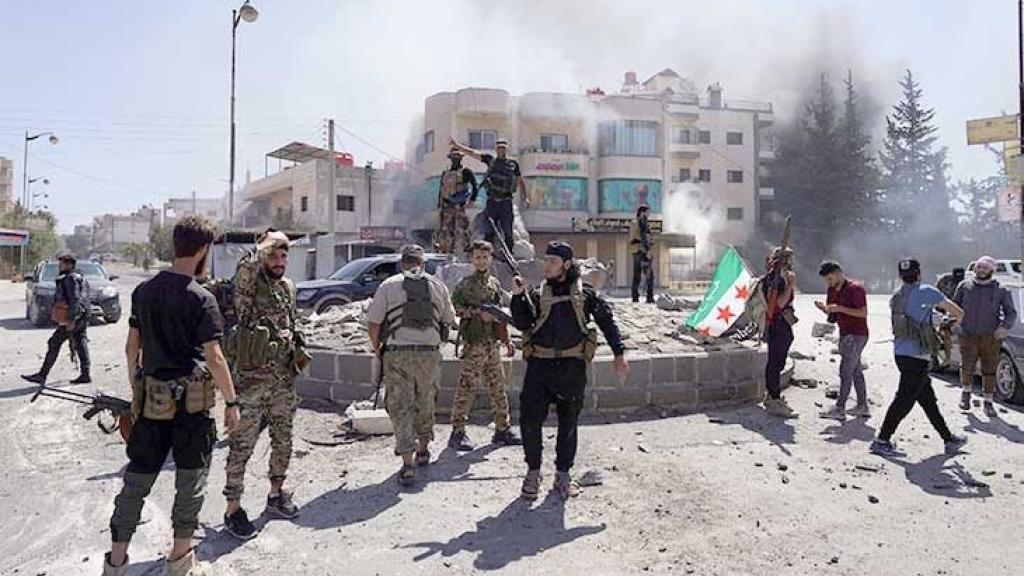Syria and the dangers of playing with fire

First published in Arabic at Al-Quds al-Arabi. Translation from Gilbert Achcar's blog.
Whatever is the origin of the recent bloody clashes in the Suwayda Governorate — whether they were merely the result of the chaos prevailing in post-Assad Syria, or a manoeuvre by Israel in order to escalate its hypocritical intervention in the region, or a manoeuvre by Hay’at Tahrir al-Sham (HTS) to extend its control over southern Syria — what is unmistakable is that the first factor, the prevailing chaos, provided the conditions for the explosion. The Bedouins who ignited the fuse by attacking a resident of the province were encouraged by the attitude of the new regime in Damascus, which is pressuring all minorities to surrender their weapons while exerting no pressure on various Sunni Arab groups. Instead, it is facilitating the arming of the latter, using them similarly to the former regime’s use of the so-called “Shabiha” (with the difference in sectarian affiliation, of course).
It is striking and extremely dangerous that the new Damascus government has not responded to repeated calls to maintain security on the road between Damascus and Suwayda. This unruliness of the situation, or rather the lack of intervention in controlling it, has paved the way for the current explosion. It could have been prevented had the government shown the same enthusiasm in controlling the Bedouin groups allied with it as it has now shown in seizing the opportunity of the clashes to enter Suwayda, offering a spectacle that looks more like an occupation than like a liberation of the local population. As Al-Quds Al-Arabi’s correspondent in Damascus wrote last Sunday:
At the end of last April, the Suwayda Governorate had witnessed an agreement between the Syrian government and the sheikhs of Suwayda stipulating the activation of police within the governorate, with the Syrian government assuming responsibility for protecting the Damascus-Suwayda road, a vital artery for hundreds of thousands of residents within the governorate. However, the continued attacks on this road and the failure to secure it for civilian traffic have exacerbated societal tensions within the Suwayda Governorate... (Heba Mohammed, “Syrian Suwayda: Deaths in Clashes Between Druze and Bedouins, and Kidnappings”, Al-Quds Al-Arabi, 13 July 2025).
Last Friday, before the outbreak of clashes in Suwayda, the Syrian Observatory for Human Rights (SOHR) warned about the chaotic situation:
Human losses continue to occur daily across Syria under various circumstances as a result of the ongoing escalating violence, military operations, targeted killings, assassinations, unexploded ordnance, and many other causes that claim the lives of many, civilians primarily and personnel from all the military forces controlling the Syrian territory. (SOHR, “Escalation of Violence in Various Syrian Regions Leaves 35 Dead in 72 Hours”, 11 July 2025, in Arabic).
The same pattern threatens to recur in other areas escaping the control of the new Damascus government, especially those with a Kurdish majority. It is well known that the Kurdish armed forces are much stronger than those in the Druze regions, and even stronger than those of HTS in its new “official” iteration. On Monday, the SOHR published a report on its website describing the Syrian government’s continued blocking of petroleum products to the predominantly Kurdish neighbourhoods of Sheikh Maqsud and Ashrafieh in Aleppo for more than 15 days. The report added that residents of the area indicated that
the authorities are using a method similar to that previously used by the Assad regime, through economic and service pressure by withholding fuel, electricity, and basic resources, in an attempt to extort political or financial concessions from the Autonomous Administration [of North and East Syria] ... (SOHR, “The Former Regime’s Method...”, 14 July 2025, in Arabic).
Given this chaotic situation, it is no surprise that Israel continues to fish in troubled waters, claiming to champion the Druze community. That is the same Israel that annexed the occupied Golan Heights in 1981, despite the opposition of the local Druze population, who overwhelmingly rejected the annexation and, along with it, the Israeli citizenship that was offered to them. The Golan Druze population even carried out a five-month general strike in 1982, which the Zionist state quelled by imposing a siege on them. Israel seized the opportunity of the new clashes in Suwayda to destroy more equipment inherited by the HTS forces from the previous Syrian regime. It certainly hopes for an escalation of violence in order to take advantage of it to strengthen the influence of the minority among the Syrian Druze that aspires to establish a Druze emirate under Israeli protection.
In the face of what is happening, allow me to recall what I wrote more than two months ago:
The blame lies primarily with those who attributed the collapse of the Assad regime exclusively to themselves … HTS should have modestly acknowledged the limitations of its own forces, which are quite weaker than those of the Kurdish forces in the northeast, and far too weak to allow it to extend its control over all the Arab regions that were controlled by the ousted regime with the assistance of Russia and Iran. Instead, Ahmad al-Sharaa got euphoric about replacing Bashar al-Assad in his presidential palace (he even began to increasingly look like a bearded version of the deposed president). He acted as if he could dominate all of Syria…
After describing the inclusive democratic process that HTS’s rule should have launched, as most of the former opposition to the Assad regime had demanded, I concluded:
These are the only conditions that can cleanse Syria’s waters and reassure the various components of its population. What the HTS regime has done so far, however, is dangerously muddying the waters, opening the way for various regional adepts of fishing in troubled waters, foremost among them the Zionist state. (“Syria: Fishing in Troubled Waters”, Al-Quds Al-Arabi, 6 May 2025).